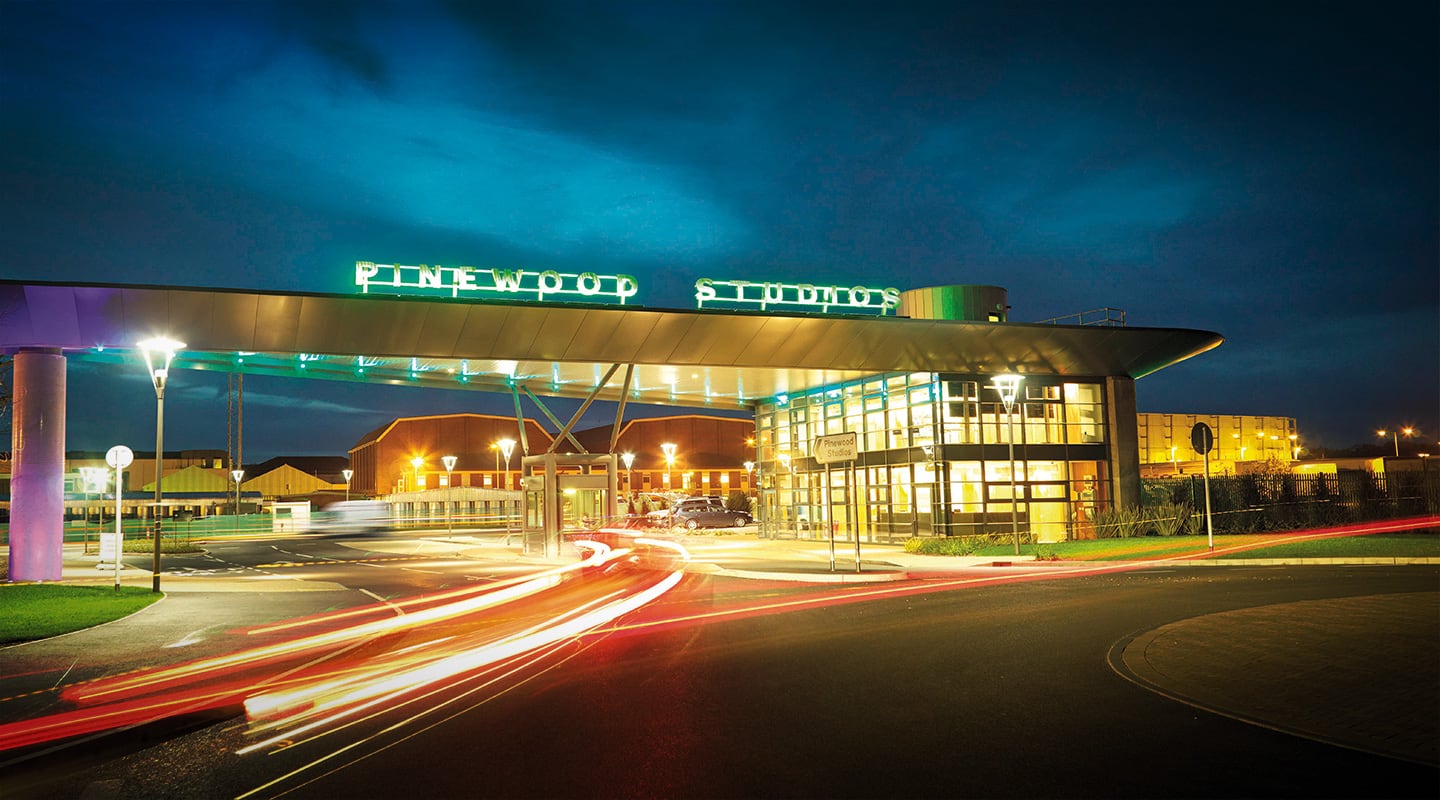
Pinewood Studios: Hollywood in the UK
Did you know that ‘Hollywood’ blockbusters like Star Wars, James Bond and Harry Potter are actually made in the UK? Welcome to Pinewood Studios.
Story: Allon Silove
Photos: © 2018 Pinewood Studios Limited
If you ask the average person where Star Wars, James Bond and Harry Potter are made, invariably they’ll answer ‘in Hollywood’ without thinking twice. Would you know it, all three mega-franchises actually call the UK home, specifically Pinewood Studios. Just 20 miles west of London, Pinewood has been one of the world’s most sought-after film studio facilities for over 80 years; not to mention the steady influx of TV productions, commercials and video games.
The facility features many large sound stages, post production facilities for both film and sound, an underwater stage, TV studios, a media hub/park with over 150 businesses in residence and the famous Heatherden Hall; a Georgian-style mansion with beautiful gardens, fountain, picturesque lake, and an interior that contains a spectacular wood-panelled boardroom and ballroom you may have spied in the odd blockbuster.
When I arrived at Pinewood Studios, I was greeted by a strict security and privacy regimen; no cameras (unless cleared by a section head, which I had) and definitely no selfies! The only photos we were sanctioned to take were those inside the theatre where I interviewed two of the studio’s most famous re-recording mixers.
Once inside, the Pinewood Studios lot is — to put it simply — huge. Massive aeroplane-size hangars wrapped in that season’s blockbuster imagery. Trucks endlessly motoring around the maze of internal streets and alleyways in a logistical masterpiece.
A familiar font, writ large on a billboard had me dreaming of stumbling onto the new Disney/Star Wars set and glimpsing a piece of the Empire. However, access to Pinewood lots is split up into secure fiefdoms. Entry by swipe-card is required at every door and gate, and attempting to enter a facility other than your designated destination is a strict ‘no-no’. In fact, as our chaperone — Paul Govey, the Group Audio Operations Manager — pointed out, even swipe card access is limited to the department you work for. No chance of eating your packed lunch while watching your favourite Hollywood leading man/woman go to work. Dreams are dashed as quickly as they’re made here.
Film fan-boy dreams aside, our interview location, the Pressburger Theatre, was a treat. One of the larger post-production Dolby surround mixing stages on the lot; it’s an impressive place to call your daily ‘office’.
FAMILY-FRIENDLY MOVIES
I met with Ian Tapp and Adam Scrivener, both re-recording mix engineers at the Pinewood facility. The pair each have over 12 years experience working on major, big budget productions; many of which I had seen and ‘Marvelled’ over. I was fascinated as to how one ends up mixing blockbusters behind a Euphonix System 5 at one of the biggest studios on earth.
Ian Tapp: I started in broadcast at the BBC, working as a sound assistant or ‘boom swinger’ on programs like Grange Hill and EastEnders. From there I was a junior mixer, up through TV documentaries, TV dramas, and eventually into feature films. It was the way the industry worked; it was expected you had your BBC training. Then I worked at Television Centre, and a facility called TVI in Soho (London). After that I worked at Anvil Studios in Denham, working with Adam’s father, in a company set up by Adam’s grandfather. I moved to Pinewood in March of 2005.
AudioTechnology: So I take it broadcast sound production runs strongly in your family, Adam?
Adam Scrivener: Yes. I’m third generation. My grandfather (and I think two or three other people, all called Kenneth for some reason) started a company called Anvil, which became part of Vidfilm and Technicolor. They ran scoring stages and had dubbing facilities as well; foley, ADR and so on. I never got to work alongside my father, he retired before I started. I guess I just caught the bug. I also worked for Vidfilm and completed a degree in audio technology at Southampton University. Then lots of freelancing in the dubbing houses in Soho before the running job came up here. I worked my way up from there.
AT: What was the transition from analogue to digital like in the broadcast world?
IT: A big organisation like the BBC had a huge sound department. There were a lot of us, spanning all ages, and it was a very busy period for program making. We’d all worked with musicians in studios using multi-track recording techniques. However, there were people who had been with the BBC since the dawn of time and still hadn’t figured out how some of the new tech worked. All us 20-year olds were fresh out of college and knew everything about it. I remember seeing the very first AMS audio file. It split the entire department down the middle; half of the sound crew thought it was the work of the devil and shouldn’t be allowed in the sound galleries! We — the younger half — very quickly proved that it made the shows better. I remember a really simple audience dub on a comedy show, recorded in front of a live audience with real laughs. We were working with quarter-inch tape and knew that laughs 16, 40 and 35 worked best every time. With the AMS file, you could stack up all those laughs on buttons. It was old jukebox software; no time code, just button thumping. In less time than it would take to get to the next laugh on a piece of quarter inch, you’ve tried every one possible. Having more variation with quicker resource access proved to be the future. That was it for tape.
You must have your session sorted, know what’s in it and set out in a way that allows you to stay in control when new ideas are being thrown at you on a minute-by-minute basis
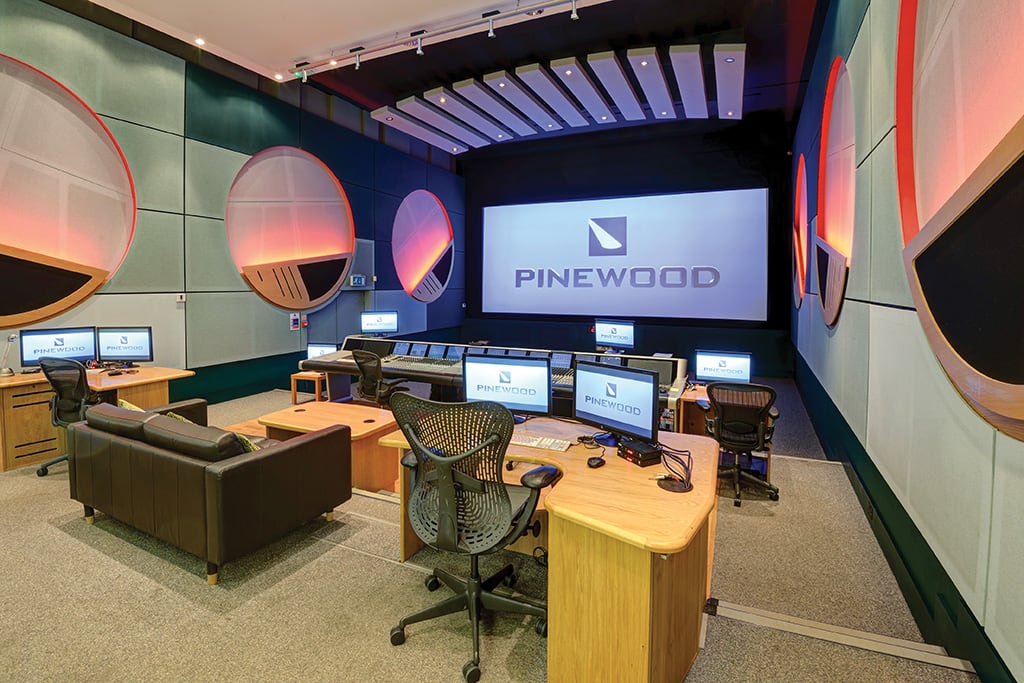
ROUTINE MIX
AT: What’s the daily routine of a re-recording mix engineer at Pinewood?
IT: As a mixer, on a typical feature film, there are basically three main stages; pre-mix stage, final mix stage, and then the deliveries stage.
AT: What does the pre-mixing stage involve?
IT: You mix the dialogue tracks prepared by the dialogue editor; cleaning up any unwanted noises and matching the camera angles. Typically, a film (reel) is shot with a single camera so any reverse angles may not have been shot on the same day or by the same technical crew. They may not even have been shot on the same continent! I’m trying to get everything to match as a continuous dramatic flow. Then I work in any replacement dialogue, which can be for technical reasons like excessive noise on a track from wind machines, or it’s an action movie with insurmountable issues no matter how good your location recording is! Sometimes, it’s because the film has taken a different turn and the script has been significantly altered during the editorial process. If it’s got a big cast you may have lots of crowd material to put in, too. They may have even shot a couple of days worth of crowd sessions just to deepen the sound of the track.
I also work alongside the supervising dialogue editor, without directors or producers. That’s our time to loop things, play things 500 times and get completely happy with it. Through that process we know the ins and outs of every track, how they got there, and that they’re as good as they can be, or as bad as they are. That way when we are in the final mix stage with the director and the producer, we’re not worrying about all of that, we can deal with the room. At that stage we’ve got all our location data, all our ADR, all our crowd finely-honed. During the process, we mix against guides of the sound effects; sometimes music, but it doesn’t often get pre-mixed. From about the tenth mix we’ve got a good idea of the shape of how the overall mix is going to be.
AT: How long does the pre-mix usually take?
AS: About a week or two. We used to say at least a day for each reel of a movie; 20 minutes of film. Five reels is about average, but films have been getting longer.
IT: I’ve just come off an eight reeler!
AT: What happens in the final mix stage?
IT: There’s usually two mixers, sometimes three, at the board. We divide up dialogue, music and effects amongst us. It can change depending on what works for the particular picture. There’ll be a Supervising Sound Editor, a Sound Designer and maybe up to four departmental Sound Editors who look after effects, foley and dialogue, all in the session with us. There’s usually a Music Editor as well, along with the Director and probably his Film Editor. The final mix is a fascinating stage, because it’s completely different every time you do it. Especially once you introduce the music, and you can really shape the dialogue and sound effects around that. From there, you’re in a pretty good place to show it to the director and producer, and it’s mostly responding to their reactions; trying to move the soundtrack so the director feels the right way about it.
DIRECTOR ONSET
AT: Do directors have a common approach to the mixing stage?
IT: Every director wants something completely different from you. Some want to completely ‘drive’ the mix at all times. They will be telling you what they want to hear and how they want to hear it. You have to engineer that for them. Other directors will just come in, sit down, put their feet up and say, ‘Okay guys, what have you got for us?’
AS: ‘Entertain me!’
IT: ‘What can you do for my movie?’ Those are the fun ones because they give you some creative rein. They also appreciate that this is what we do. To them, it may just be one part of their filmmaking process, but it’s our specialty! There’s also a good chance we can come up with some good ideas they haven’t thought of yet.
AS: Or because they get ‘temp love’.
AT: What’s ‘temp love’?
AS: A director and a film editor will often work for three months or so in a cutting room on an Avid (suite) and get really used to the rough soundtrack; a temporary mix we may have done. It usually has good structure to it and because the director and film editor are concentrating on broader aspects of the film, they can fall in love with the temporary sound. The problem is that when they hear the final mix it’s a case of, ‘I liked the sound that was there, and now it’s gone!’ ‘Yeah, it was just a crew member bumping something so we took it out.’ That happens all the time, particularly with music.
IT: Particularly with directors who enjoy the process. Other directors have to virtually be dragged kicking and screaming to the theatre. Some of them just don’t do it. The process of us going back and forth over the same pass and mixing about 15 to 20 minutes of material in a day is painful for them. They want to see something they can react to and comment on. It’s not uncommon for the sound crew to work in the morning and the directors to come in after lunch, which is the best way of doing it.
AT: How much control do you have over the music mix, the multi-tracks of the scoring sessions?
AS: Generally it’s delivered mixed from the studio. We get involved with the music only in the final mix and then we wrangle it in there.
IT: Music’s an interesting thing. It’s the last thing to arrive, in the last fortnight of the film’s life. The composer can still be in the scoring stage when we’re already in the pre mixing stage. That’s when things can get really tight.
AT: Is the final process of mastering done here as well?
IT: Yes. We’ll take it all the way through, so we’ll typically work two or three weeks on a final mix, followed by mastering. In today’s multi-format world, you could be producing four separate mixes, even for theatrical release; Dolby Atmos, 7.1, 5.1, and two-track mixes for archive. We’ll spend a couple of days mastering if it’s Atmos and we need to do down-renders, maybe only one if it’s just a 5.1 mix.
AT: Do you also do the post theatrical release for Blu-ray, or DVD releases?
IT: More often that not, but it’s on a title-by-title basis. We’ve got smaller mixing theatres for the nearfield mixes, though sometimes we also put up nearfield monitors in the big rooms.
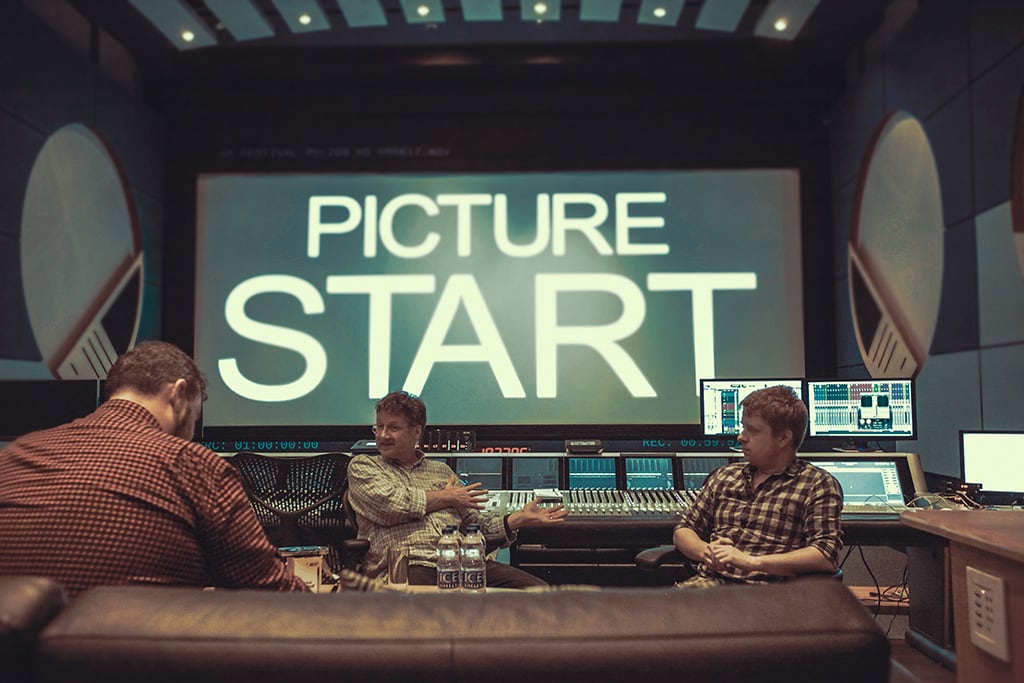
INDISPENSABLE GEAR
AT: I noticed all the monitoring here is JBL. Do you prefer their sound to other brands?
AS: This particular theatre is a 7.1 monitoring system: JBL three-way system on the screen, bi-amped using Crown amps. The JBLs do have their own style of sound but we’re all comfortable with that sound. We can move rooms without being upset or introducing another variable. The JBLs are more like what you hear at your local multiplex.
IT: Consistency from room to room is important because you can end up working in two or three rooms across one project.
AT: I would imagine workflow is very important. What makes up your tool kit?
IT: I would be a bit panicked without Izotope, these days!
AS: Yeah, RX is my favourite tool right now! De-Noise and also their Ambience Match tool is quite cool. It’s a fast way to solve a problem. It’s not necessarily what you’d do if you had more time, but it is good. I wouldn’t want to go into a mix without it. That aside, most plug-ins achieve the same thing in different ways. So long as you’ve got something that’s going to compress, an EQ and a bit of reverb, you’re essentially covered. If we’re mixing on these AVID System 5 boards, I tend to use the channel strip from Pro Tools because it maps nicely to the surface and the ergonomics outweigh any sonic benefit of a different plug-in choice. Ultimately it’s about time; the speed of operation is important.
IT: It’s also a sweet-sounding EQ.
AT: How does the System 5 help your workflow or process?
AS: I like the way it creates separation from the editor’s sessions, and it’s useful when you’ve got very complicated sessions, specifically dealing with the music. A dialogue session is quite easy to mix in the box because it’s a lump of sound on a track with a fader on it. The sessions are much narrower and more manageable than something like a music or effects session. When you’re mixing in the final stage, you just want to be able to get the music out and on to faders. It’s probably just a psychological thing, but partly it’s practical. Having separation, between those of us mixing music versus those mixing dialogue or effects, means we can be mixing on the faders while the editor is doing their thing on Pro Tools completely independently. You’re not fighting over control of the system or worried by the wrong things. It’s still, to my mind, the fastest surface to use because the feedback’s brilliant; one button always takes you to where you make a change. We’ve been using this the System 5 for 10-12 years now so its like muscle memory.
AT: What is an average final mix session track count?
AS: To give you a sense, on just the effects side of the board we’d probably have sixteen 5.1 tracks coming into the console from Pro Tools, then at least an additional 20 tracks of foley, and potentially another eight 5.1 faders of background as well. It’s about as big as you can go without losing things.
IT: You’ve got to be able to ‘wrangle it’ in the final mix. You can’t say to a director, ‘If you want to step out for 40 minutes, I’ll find that audio for you!’ You must have your session sorted, know what’s in it and set out in a way that allows you to stay in control when new ideas are being thrown at you on a minute-by-minute basis.
AT: The BBC was a training ground for a large proportion of British engineers, does Pinewood offer internships for finding your next generation?
AS: We do have an apprentice scheme. However, more people are going into the sound editorial side than pre-mixing. It’s diversifying because the traditional approach of coming in at a certain level and working your way up to being a sound mixer is not the pathway anymore. Sound editorial and sound mixing are becoming much more of a whole.
IT: We might just be dinosaurs ourselves soon.








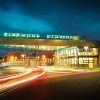




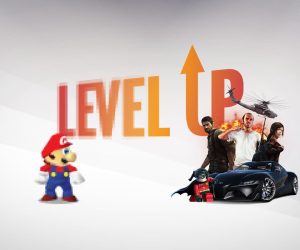
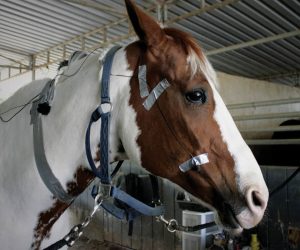
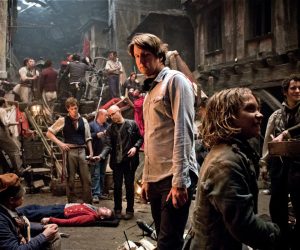










RESPONSES